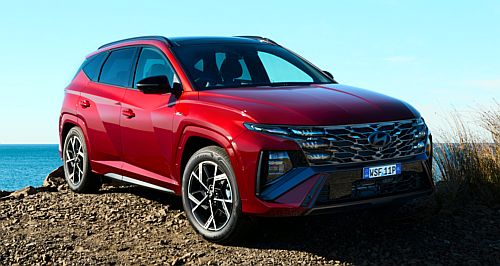Make / Model Search
New models - Hyundai - TucsonRevised Tucson arrives with hybrid optionHyundai continues electrification program with new 17-variant Tucson Hybrid line-up15 Jul 2024 HYUNDAI’S progress down the electrified road gathers momentum this week with the availability of a hybrid Tucson range as part of a comprehensive mid-life model update for the medium SUV.
It includes Atkinson-cycle 2.0-litre naturally aspirated and 1.6-litre turbo petrol engines along with a 1.6-litre turbo-petrol hybrid in front- and all-wheel drive formats, ready to take on Toyota’s successful RAV4 hybrid and others in Australia’s most-competitive segment.
Pricing across the 17 variants in Tucson, Elite and Premium grades starts at $39,100 for the entry-level Tucson 2.0-litre petrol FWD extending to $61,100 for the Premium Hybrid AWD N-Line (both excluding on-road costs).
Both the N-Line pack and hybrid powertrain are available across the entire Tucson line-up.
By comparison, Toyota’s RAV4 range starts at $39,760 + ORC for the 2.0 GX FWD petrol base grade to $58,360 + ORC for the 2.5 Edge AWD Hybrid, while the Honda CR-V opens from $44,700 drive-away for the base model to $59,900 d/a for the e:HEV front-drive hybrid.
Mitsubishi’s popular Outlander is priced from $37,740 + ORC for a base petrol up to $73,790 + ORC for the top-spec AWD plug-in hybrid while the new Nissan X-Trail range spans $37,250 + ORC (petrol) to $58,490 + ORC (top-spec E-Power hybrid).
Hyundai Motor Company Australia (HMCA) sits in sixth place sales-wise and needs vehicles like the hybrid Tucson if it is to elevate itself to an aspirational position ahead of sister brand Kia and potentially in front of third-placed Mazda which is undergoing a sales slump of its own.
The Tucson hybrid joins other recently released Hyundai models offering a hybrid powertrain choice including the Kona and the hybrid-only (for now) new-generation Santa Fe large SUV.
Externally, the revised Tucson is little different from its predecessor with minor changes to the lights, grille, aerodynamics and bumpers plus new-look alloy wheels combining to what Hyundai describes as an “evolved”.
The N-Line option gives the Tucson a sportier, more aggressive appearance focusing on the grille, blacked-out body parts and different wheels with a dual outlet exhaust and new badging.
Interior changes revolve around the new curved screen that spans more than half the dash incorporating a number of read-outs including an infotainment touch screen and driver instrumentation.
Adding to the interior overhaul is a predominance of horizontal lines, new ambient lighting and a floating centre console with conventional buttons and dials for critical functions. The interior is available in three colour schemes including a green/grey while the sporty N-Line treatment is replete with red piping to the suede seats and sporty fascia materials.
Powertrain choices comprise a 115kW/192Nm 2.0-litre four-cylinder petrol (FWD only with six-speed automatic transmission), 132kW/264Nm 1.6-litre turbocharged four-cylinder (FWD and AWD with seven-speed dual-clutch transmission) and 1.6-litre turbo-petrol four-cylinder hybrid (FWD and AWD) with the traction motor incorporated into its six-speed auto for a combined 172kW/367Nm.
Fuel consumption for the 2.0-litre is a claimed combined 8.1L/100km, the 1.6 turbo a claimed 6.7L/100km (FWD) or 7.2L/100km (AWD) and the Hybrid returns a claimed 5.3L/100km for both FWD and AWD variants, all on 91 RON petrol.
The Tucson hybrid features what Hyundai refers to as E-Motion Drive encompassing among other systems E-Comfort Drive which minimises pitching over speed bumps and controls the motor for smoother acceleration.
Another feature called E-Dynamic Drive controls motor torque to optimise traction during corning, reduces slip and improves steering responsiveness, and the ICE engine and electric motor have unified control for torque vectoring to improve handling.
Paddle-shifters on the Hybrid control regenerative braking as well as gear selection with four energy recuperation levels available. The AWD hybrid models offer Terrain mode with Snow, Mud and Sand settings.
Baby mode is also on the hybrids for a smoother application of brakes when parking and smoother accelerating to keep ‘bub’ happy.
The 2.0-litre and the 1.6 Turbos can tow up to 1650kg while both Hybrids (FWD and AWD) are rated at 1900kg.
Hyundai has upped the ante in terms of Tucson standard equipment with all variants featuring auto windows up and down, full LED interior lighting, LED front and rear combination lights, head-up display, smart key with push start, 12.3-inch instrument cluster and 12.3-inch multimedia screens, 18-inch alloys, dual-zone climate control, Bluelink connected car services and over-the-air updates, and a new column-mounted transmission selector.
Safety has similarly been enhanced with the addition of forward and reverse parking distance warning, crosswind stability control, intelligent speed limit assist, high beam assist, highway driving assist, forward collision avoidance assist and navigation-based smart cruise control.
HMCA product planning assistant manager responsible for Tucson, Naomi Channell said: “The new Tucson is the best yet and will appeal to a broad demographic including couples, empty nesters and families.
“We expect it to be popular as it remains a value proposition with improvements that represent a massive upgrade to more than offset the price rises.”
2024 Hyundai Tucson Pricing*
*Excludes on-road costs  All new modelsTucson pricing
Motor industry news |
|

 Alfa Romeo
Alfa Romeo Abarth
Abarth Audi
Audi Aston Martin
Aston Martin BMW
BMW Bentley
Bentley Ferrari
Ferrari Chevrolet
Chevrolet Ford
Ford Fiat
Fiat GWM
GWM Foton
Foton Hyundai
Hyundai Honda
Honda Jaguar
Jaguar Isuzu
Isuzu Kia
Kia Jeep
Jeep Land Rover
Land Rover Lamborghini
Lamborghini Maserati
Maserati Lexus
Lexus McLaren
McLaren Mazda
Mazda Mercedes-Benz
Mercedes-Benz Mitsubishi
Mitsubishi Mini
Mini Peugeot
Peugeot Nissan
Nissan Ram
Ram Porsche
Porsche Rolls-Royce
Rolls-Royce Smart
Smart Skoda
Skoda Suzuki
Suzuki Subaru
Subaru Toyota
Toyota Tesla
Tesla Volvo
Volvo Zeekr
Zeekr







Facebook Twitter Instagram